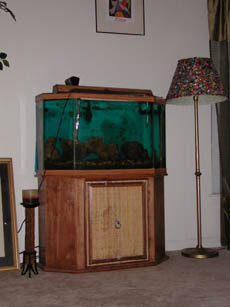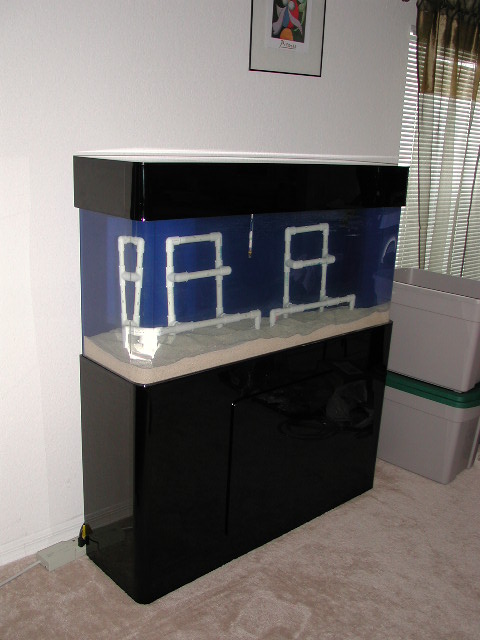|
Welcome
I had been running and maintaining a marine (saltwater) tank for many years now and decided that it was time to upgrade my system. During the migration I took lots of pictures and jotted down the story as it unfolded -- you've stumbled upon that journal and are welcome to read and learn from my experience of upgrading my marine aquarium.
You can start reading my brief aquaria history below, browse the complete journal of upgrading the system (the navigation to the left) or see the latest news on the new tank.
A Brief History
 During my years of freshwater aquaria, I discovered the challenge of marine keeping and purchased from a co-worker a half-hex, 33 gallon, glass aquarium originally setup as a goldfish tank (yuck) for under $100 US to help me get started. It was a good-size tank to begin creating an ecosystem for marine life and ran very well for more than four years. During my years of freshwater aquaria, I discovered the challenge of marine keeping and purchased from a co-worker a half-hex, 33 gallon, glass aquarium originally setup as a goldfish tank (yuck) for under $100 US to help me get started. It was a good-size tank to begin creating an ecosystem for marine life and ran very well for more than four years.
The filtration system consisted of a mechanical filter, protein skimmer and a bio wheel fed by the under gravel filter (which were still the rage back then) via a powerhead pump. It was definitely not a sophisticated system and was fairly self-maintaining and inexpensive -- a very good learning experience.
Of course, research and opinions have changed about micro-ecosystem filtration. Natural, simple filtration systems have been brought to life as fancy equipment has, thankfully, taken a back seat. Between that and the fact that my old tank was simply outdated, showing signs of aging and constantly encrusted with salt deposits on the top of the tank made me decide to upgrade the system completely. Alternatively I could have taken down the old tank completely and started fresh with almost all of the same equipment, but the benefits of doing so were few compared to a new system.
Simply, the task was to research and purchase a larger aquarium and filtration system to replace my old setup. I discovered, after scouring the internet for days, that little or no information on just HOW to go about upgrading an existing tank existed. The most difficult part of this transition, to me, was to plan out how I was going to do this as easily and smoothly as possible, keeping my long-time fishes alive and well and positioning the new tank in the same spot as the old.
The New Tank
 Glass or acrylic? It wasn't an easy decision to make, and I've only ever owned glass, but after reading SOO many opinions, debates, arguments and flame wars about which is better, I decided acrylic was what I wanted. Why? Glass or acrylic? It wasn't an easy decision to make, and I've only ever owned glass, but after reading SOO many opinions, debates, arguments and flame wars about which is better, I decided acrylic was what I wanted. Why?
- Flexible
Not flexible as in bendable (although it is that too), but flexible in the sense that it can be custom made with lots of options. It's drillable, allowing for hidden compartments and filtration and it can be made in many shapes and sizes.
- Light weight
Apartment life means you eventually move. Moving a large glass aquarium is not fun :)
- Very clear
Super clear. I'm still amazed at how much clearer it is than my glass aquariums.
- Well insulated
Living in Florida can mean wide temperature changes. In the summer, 102°F. In the winter, 50°F. Although acrylic holds heat in much moreso than glass, keeping a constant steady temperature was my goal, even if it was in the high range. With my glass aquarium, the heater runs constantly all through the year wasting electricity.
- Safe
Highly debated, but my opinion is that acrylic is no more likely to split, shatter or pull apart than glass. In fact, it won't shatter at all. Years ago I wouldn't have said the same, and I have read many, many accounts of BOTH types of tanks breaking.
- Cleaner
An acrylic tank would have an acrylic top with access holes instead of a completely open top. This could help keep salt deposits from the evaporation of water inside the tank and/or hidden by the canopy and stand rather than built up around the edge of the canopy.
Downsides to acrylic? Yes, depending upon your point of view.
- Expensive
It's not cheap. For what you'd pay for a glass setup, you'd pay a LOT more for in an acrylic one.
- It bows
Acrylic is flexible and it bows under water pressure depending upon thickness. A well made and more expensive one will bow little or none at all.
- Can be scratched easily
Although if your careful, you can keep from scratching it. However, there are scratch removal kits available that work wonderfully (even underwater with your fish in the tank); something I can't say for glass, which can also scratch.
- Access holes
Instead of a large, open top access to the tank, there are two smaller access holes of fixed dimension that everything must fit through to get inside the tank. (Fortunately though, they're usually pretty big holes)
In the end, I chose a Tenecor 55gal , standard size (48" x13" x20"), "reef-ready" filtration aquarium and stand. Their reputation, customer service and feature-set proved to be my favorite. Each tank and stand is made-to-order and you can choose the background acrylic, filtration system, lighting and more, and although I hadn't planned to, I did purchase directly from them since their price was surprisingly competitive even with the wholesalers!
|

